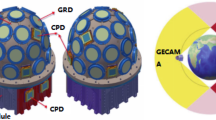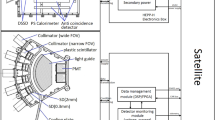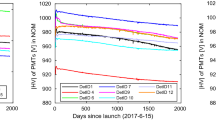Abstract
The Mars radiation environment, both in past and at present, plays a vital role in the evolution of Martian atmosphere, so it is necessary to detect the background radiation environment both in the Martian atmosphere and the transfer orbit from Earth to Mars. The Tianwen-1 Energetic Particle Analyzer (EPA) is designed to measure and analyze the energetic charged particles emitted to the Martian atmosphere. Mars-EPA consists of two parts: one is the Mars-EPA sensor head and the other is the Mars-EPA electronics system. This paper begins with an introduction of Mars-EPA structure and function of each part, followed by a simulation of how sensor head structure is designed. It then evaluates the performance of detection system using Geant4 software, to whether this sensor is capable of identifying the target particle and proposes a reasonable ground calibration procedure, which allows on overall detection performance to some degree. This Mars-EPA has demonstrated a potentially high capability and configurability which hopefully will shed light on future development of compact energetic detectors in deep space exploration.




















Similar content being viewed by others
References
A. Anastasiadis, D. Lario, A. Papaioannou et al., Solar energetic particles in the inner heliosphere: status and open questions. Philos. Trans. - Royal Soc., Math. Phys. Eng. Sci. 377, 20180100 (2019)
M.J. Aschwanden, A. Caspi, C.M.S. Cohen et al., Global energetics of solar flares. V. Energy closure in flares and coronal mass ejections. Astrophys. J. 836, 17 (2017)
J. Barthel, N. Sarigul-Klijn, Radiation production and absorption in human spacecraft shielding systems under high charge and energy Galactic Cosmic Rays: material medium, shielding depth, and byproduct aspects. Acta Astronaut. 144, 254–262 (2018)
O.V. Belov, K.V. Belokopytova, V.S. Kudrin et al., Neurochemical insights into the radiation protection of astronauts: distinction between low-and moderate-LET radiation components. Phys. Med. 57, 7–16 (2019)
J.B. Blake, B.H. Mauk, D.N. Baker et al., The fly’s eye energetic particle spectrometer (FEEPS) sensors for the magnetospheric multiscale (MMS) mission. Space Sci. Rev. 199(1–4), 309–329 (2016)
X. Cui, Y. Liu, W. Peng et al., Energetic particles’ fluxes and dose in the Radiation Gene Box measured by space radiation detector onboard SJ-10 satellite. Radiat. Detect. Technol. Methods 2(2), 43 (2018)
B. Ehresmann, D.M. Hassler, C. Zeitlin et al., Energetic particle radiation environment observed by RAD on the surface of Mars during the September 2017 event. Geophys. Res. Lett. 45, 5305–5311 (2018)
J. Guo, C. Zeitlin, R.F. Wimmer-Schweingruber et al., Variations of dose rate observed by MSL/RAD in transit to Mars. Astron. Astrophys. 577, A58 (2015a)
J. Guo, C. Zeitlin, R.F. Wimmer-Schweingruber, D.M. Hassler et al., MSL-RAD radiation environment measurements. Radiat. Prot. Dosim. 166(1–4), 290–294 (2015b)
D.M. Hassler, J.W. Norbury, Mars Science Laboratory Radiation Assessment Detector (MSLRAD) modeling workshop proceedings. Life Sci. Space Res. 14, 1 (2017)
D.M. Hassler, C. Zeitlin, R.F. Wimmer-Schweingruber et al., Mars’ surface radiation environment measured with the Mars Science Laboratory’s Curiosity rover. Science 343(6169), 1244797 (2014)
H.-Q. He, Perpendicular diffusion in the transport of solar energetic particles from unconnected sources: the counter-streaming particle beams revisited. Astrophys. J. 814, 157 (2015)
H.-Q. He, W. Wan, Numerical study of the longitudinally asymmetric distribution of solar energetic particles in the heliosphere. Astrophys. J. Suppl. Ser. 218, 17 (2015)
H.-Q. He, W. Wan, On the east-west longitudinally asymmetric distribution of solar proton events. Mon. Not. R. Astron. Soc. 464, 85–93 (2017)
H.-Q. He, G. Qin, M. Zhang, Propagation of solar energetic particles in three-dimensional interplanetary magnetic fields: in view of characteristics of sources. Astrophys. J. 734, 74 (2011)
H.-Q. He, G. Zhou, W. Wan, Propagation of solar energetic particles in three-dimensional interplanetary magnetic fields: radial dependence of peak intensities. Astrophys. J. 842, 71 (2017)
C.J. Joyce, N.A. Schwadron, J.K. Wilson et al., Radiation modeling in the Earth and Mars atmospheres using LRO/CRaTER with the EMMREM module. Space Weather 12, 112–119 (2014)
M.-B. Kallenrode, A statistical study of the spatial evolution of shock acceleration efficiency for 5 MeV protons and subsequent particle propagation. J. Geophys. Res. 102, 22335 (1997)
S.M. Krimigis, T.P. Armstrong, W.I. Axford et al., Low-energy charged particles in Saturn’s magnetosphere: results from Voyager 1. Science 212(4491), 225–231 (1981)
D. Lario, A. Aran, R. Gómez-Herrero et al., Longitudinal and radial dependence of solar energetic particle peak intensities: STEREO, ACE, SOHO, GOES, and MESSENGER observations. Astrophys. J. 767, 41 (2013)
D.E. Larson, R.J. Lillis, C.O. Lee et al., The MAVEN solar energetic particle investigation. Space Sci. Rev. 195(1–4), 153–172 (2015)
N. Lugaz, M. Temmer, Y. Wang et al., The interaction of successive coronal mass ejections: a review. Sol. Phys. 292(4), 64 (2017)
D. Matthiä, T. Berger, The radiation environment on the surface of Mars–numerical calculations of the galactic component with GEANT4/PLANETOCOSMICS. Life Sci. Space Res. 14, 57–63 (2017)
B.H. Mauk, D.K. Haggerty, S.E. Jaskulek et al., The Jupiter energetic particle detector instrument (JEDI) investigation for the Juno mission. Space Sci. Rev. 213(1–4), 289–346 (2017)
U.W. Nam, W.K. Park, J. Lee et al., Calibration of TEPC for CubeSat experiment to measure space radiation. J. Astron. Space Sci. 32(2), 145–149 (2015)
S.K. Nielsen, M. Stejner, J. Rasmussen et al., Measurements of the fast-ion distribution function at ASDEX upgrade by collective Thomson scattering (CTS) using active and passive views. Plasma Phys. Control. Fusion 57(3), 035009 (2015)
D.V. Reames, Particle acceleration at the Sun and in the heliosphere. Space Sci. Rev. 90, 413 (1999)
T. Sato, A. Nagamatsu, H. Ueno et al., Comparison of cosmic-ray environments on Earth, Moon, Mars and in spacecraft using PHITS. Radiat. Prot. Dosim. 180(1–4), 146–149 (2017)
N.A. Schwadron, F. Rahmanifard, J. Wilson et al., Update on the worsening particle radiation environment observed by CRaTER and implications for future human deep-space exploration. Space Weather 16(3), 289–303 (2018)
L. Teodoro, A. Davila, R.C. Elphic et al., Habitability and biomarker preservation in the martian near-surface radiation environment, in From Habitability to Life on Mars (2018), pp. 211–231
M.E. Wiedenbeck et al., Observations of solar energetic particles from 3He-rich events over a wide range of heliographic longitude. Astrophys. J. 762, 54 (2013)
C. Zeitlin, D.M. Hassler, F.A. Cucinotta et al., Measurements of energetic particle radiation in transit to Mars on the Mars Science Laboratory. Science 340, 1080–1084 (2013)
C. Zeitlin, D.M. Hassler, J. Guo et al., Analysis of the radiation hazard observed by RAD on the surface of Mars during the September 2017 solar particle event. Geophys. Res. Lett. 45(12), 5845–5851 (2018)
Acknowledgement
All the authors acknowledge support from the China National Space Administration. This work is supported by the Engineering and Technological Research Project on Civil Aerospace technologies of the CNSA.
Author information
Authors and Affiliations
Corresponding authors
Additional information
Publisher’s Note
Springer Nature remains neutral with regard to jurisdictional claims in published maps and institutional affiliations.
The Huoxing-1 (HX-1) / Tianwen-1 (TW-1) mission to Mars
Edited by Chunlai Li and Jianjun Liu
Rights and permissions
About this article
Cite this article
Li, C., Tang, S., Hu, X. et al. Design and Realization of China Tianwen-1 Energetic Particle Analyzer. Space Sci Rev 217, 26 (2021). https://doi.org/10.1007/s11214-021-00803-0
Received:
Accepted:
Published:
DOI: https://doi.org/10.1007/s11214-021-00803-0




